市场营销原理principles of marketing
- 格式:ppt
- 大小:327.08 KB
- 文档页数:26
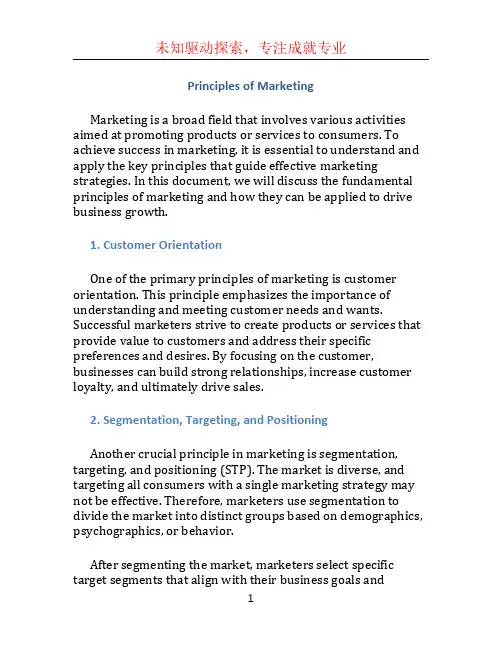
Principles of MarketingMarketing is a broad field that involves various activities aimed at promoting products or services to consumers. To achieve success in marketing, it is essential to understand and apply the key principles that guide effective marketing strategies. In this document, we will discuss the fundamental principles of marketing and how they can be applied to drive business growth.1. Customer OrientationOne of the primary principles of marketing is customer orientation. This principle emphasizes the importance of understanding and meeting customer needs and wants. Successful marketers strive to create products or services that provide value to customers and address their specific preferences and desires. By focusing on the customer, businesses can build strong relationships, increase customer loyalty, and ultimately drive sales.2. Segmentation, Targeting, and PositioningAnother crucial principle in marketing is segmentation, targeting, and positioning (STP). The market is diverse, and targeting all consumers with a single marketing strategy may not be effective. Therefore, marketers use segmentation to divide the market into distinct groups based on demographics, psychographics, or behavior.After segmenting the market, marketers select specific target segments that align with their business goals andcapabilities. Once the target audience is identified, positioning comes into play. Positioning involves creating a unique and compelling brand image in the minds of consumers, differentiating the product or service from competitors. By leveraging STP, marketers can develop tailored marketing campaigns that resonate with the target audience, leading to higher engagement and conversion rates.3. Marketing MixThe marketing mix is a set of core elements that marketers manipulate to achieve their objectives. It consists of the four Ps: Product, Price, Place, and Promotion. These elements work together to create a comprehensive marketing strategy.•Product: This element focuses on developing and offering products or services that meet customer needs. It includes product design, features, packaging, quality, andbranding.•Price: The price element involves determining the optimal pricing strategy for a product or service. It takesinto consideration factors such as production costs,competitor pricing, and perceived value by customers.•Place: This element refers to the distribution and availability of the product or service. It involves selectingappropriate distribution channels and ensuring that theproduct is accessible to the target audience.•Promotion: Promotion encompasses all activities that communicate and promote the product or service tothe target audience. It includes advertising, public relations, sales promotions, and direct marketing.By carefully managing the marketing mix, businesses can create a compelling offering that attracts customers and drives sales.4. Integrated Marketing CommunicationIntegrated Marketing Communication (IMC) is the concept of coordinating all marketing communication efforts to deliver a consistent and unified message. This principle recognizes that customers receive information through various channels, and consistency across these channels is crucial for effective marketing.IMC involves integrating different communication tools, such as advertising, public relations, sales promotions, and direct marketing, to create a seamless and synchronized message. By coordinating these efforts, businesses can reinforce their message, enhance brand awareness, and establish a strong brand identity in the minds of consumers.5. Continuous Monitoring and AdaptationMarketing is not a one-time effort but an ongoing process that requires continuous monitoring and adaptation. Successful marketers regularly track key performance indicators, market trends, and customer feedback to evaluate the effectiveness of their strategies. They are also prepared to make necessary adjustments to their marketing plans to stay relevant and meet changing consumer demands.Continuous monitoring enables businesses to identify opportunities, identify potential pitfalls, and optimize their marketing efforts in real-time. By staying agile and responsive, marketers can maintain a competitive edge, improve customer satisfaction, and drive long-term business growth.In conclusion, these principles of marketing provide a foundation for creating effective marketing strategies. By putting the customer at the center, segmenting the market, leveraging the marketing mix, implementing integrated marketing communication, and continuously monitoring and adapting, businesses can effectively promote their products or services, engage their target audience, and achieve their marketing objectives.。
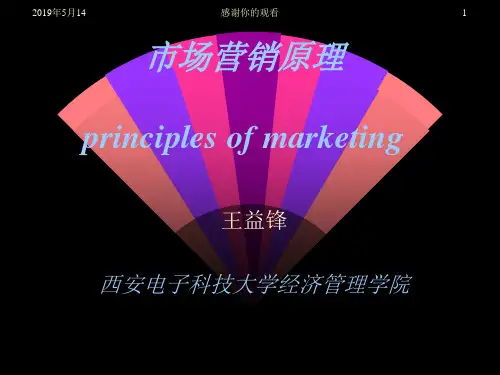

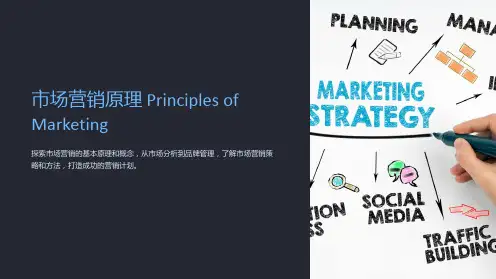
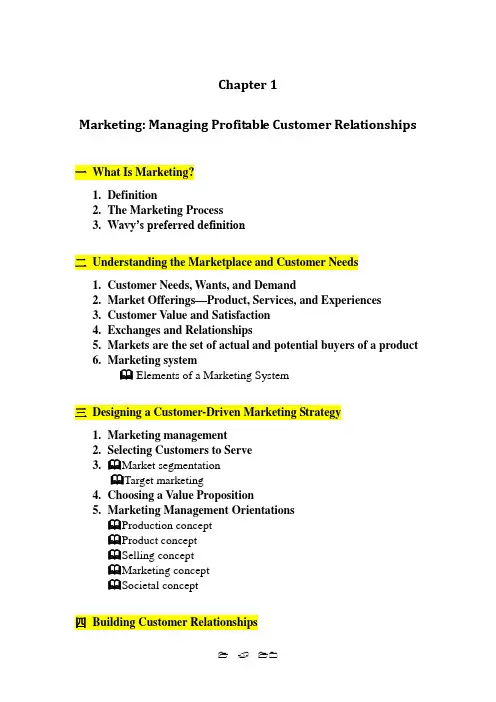
Chapter 1Marketing: Managing Profitable Customer Relationships一What Is Marketing?1.Definition2.The Marketing Process3.Wavy’s preferred definition二Understanding the Marketplace and Customer Needs1.Customer Needs, Wants, and Demand2.Market Offerings—Product, Services, and Experiences3.Customer Value and Satisfaction4.Exchanges and Relationships5.Markets are the set of actual and potential buyers of a product6.Marketing systemElements of a Marketing System三Designing a Customer-Driven Marketing Strategy1.Marketing management2.Selecting Customers to Serve3. Market segmentationTarget marketing4.Choosing a Value Proposition5.Marketing Management OrientationsProduction conceptProduct conceptSelling conceptMarketing conceptSocietal concept四Building Customer RelationshipsCustomer Relationship Management (CRM)Chapter 2Company and Marketing Strategy:Partnering to Build Customer Relationships一Companywide Strategic Planning: Defining Marketing’s Role1.Strategic Planning for a businessStrategic Planning2.Steps in the Strategic Planning Process3. Defining a Market-Oriented Missiona)The mission statementb)Market-oriented mission statementSetting Company Objectives and Goalsa)Business objectivesb)Marketing objectivesDesigning the Business Portfolio1)Definition1)Analyzing the business portfolio1)Strategic business unit (SBU)1)The Boston Group Approacha.Growth share matrixa.SBUs are classified as: Stars; Cash cows; Questionmarks; Dogs.Developing Strategies for Growth and Downsizinga)Product/market expansion gridb)P roduct/market expansion grid strategiesi.Market penetrationi.Market developmenti.Product developmenti.Diversification二Marketing Strategy and the Marketing Mix1.Marketing Strategy1.Customer-Centered Marketing StrategyMarket segmentationMarket segmentTarget marketingMarket positioning1.Developing the Marketing MixThe Four PsThe 4 Ps versus The 4 Cs三.Managing the Marketing Effort1.The Marketing Effort1.Marketing Analysis1.SWOT AnalysisChapter 4Managing Marketing Information一Assessing Marketing Information Needs Marketing information system (MIS)二Developing Marketing InformationMarketing ResearchDefinitionSteps in the marketing research processa)Defining the problem and research objectivesb)Developing the research planc)Implementing the pland)Interpreting and reporting the findingsChapter 5Consumer Markets and Consumer Buyer Behavior 一Model of Consumer Behavior二Characteristics Affecting Consumer BehaviorFactors Influencing Consumer Behavior三Types of Buying Decision Behaviorplex Buying Behavior1.Dissonance-Reducing Buying Behavior1.Habitual Buying Behavior1.Variety-Seeking Buying Behavior四The Buyer Decision Process1.Post-Purchase DecisionCustomer satisfactionNew productAdoption process1.Stages in the Adoption ProcessAwarenessInterestEvaluationTrialAdoption1.Individual Differences in InnovationEarly adoptersEarly majorityLate majorityLaggards1.Adoption Categorization on the Basis of Relative TimeAdoption of InnovationsChapter 7Customer-Driven Marketing Strategy:Creating Value for Target CustomersChapter Concepts:(1)Market Segmentation(2)Market Targeting(3)Differentiation and Positioning一Market Segmentation1.Definition1.Segmenting Consumer Markets1. Geographic segmentation1. Demographic segmentation1. Psychographic segmentation1. Behavioral segmentation1.Requirements for Effective SegmentationMeasurableAccessibleSubstantialDifferentiableActionable二Market Targeting1.Evaluating Market Segments2.Target Marketing StrategiesDepends on:Company resourcesProduct variabilityProduct life-cycle stageMarket variabilityCompetitor’s marketing strategies三Differentiation and Positioning1.Product position2.Choosing a Target Market3.Choosing a Differentiation and Positioning Strategy4.Choosing the Right Competitive Advantage5.Developing a Positioning StatementChapter 8Product, Services, and Branding Strategy一What Is a ProductProducts, Services, and Experiences二Services MarketingNature and Characteristics of a ServiceIntangibilityInseparabilityVariabilityPerishability三What Is a Product1.Levels of Product and Services2.Product and Service Classificationsanizations, Persons, Places, and Ideas四Product and Services Decisions1.Individual Product and Service Decisions1.Product Line Decisions1.Product Mix Decisions五Branding Strategy: Building Strong Brands1.Definition of Brand equity and Customer equity2.Brand strategy decisions include:3. Brand positioning4. Brand name selection5. Brand sponsorship6. Brand developmentChapter 9New-Product Development and Product Life-CycleStrategies一New-Product Development Strategy1. A firm can obtain new products through:2. Acquisition3. New-product development4.Reasons for new product failure二New-Product Development Process1.Major Stages in New-Product Development2.Idea Generation3.Concept Development and Testing4.Marketing Strategy Development三New-Product Development ProcessCommercialization四Managing New-Product DevelopmentSuccessful new-product development should be:Customer centeredTeam centeredSystematic五Product Life-Cycle Strategies1.Product Life Cycle2.Production Life-Cycle Stages3.Modifying Strategies4.Production Life-Cycle Stages六Additional Product and Service Considerations1.Product Decisions and Social Responsibility2.International Product and Service MarketingChapter 10Pricing ConceptsUnderstanding and Capturing Customer Value Chapter Outline1.What Is a Price?2.Factors to Consider When Setting Prices一What Is a Price?Definition二Factors to Consider When Setting Prices1.Customer Perception of Valuepany and Product Costs1.Costs at Different Levels of Production1.Costs as a Function of Production Experience1.Break-Even Analysis and Target Profit Pricing1.Other Internal and External Consideration Affecting PriceDecisionsChapter 11Pricing Products: Pricing Strategies Chapter Outline1.New-Product Pricing Strategies2.Product Mix Pricing Strategies3.Price Adjustment Strategies4.Price Changes5.Public Policy and Pricing一New-Product Pricing StrategiesPricing StrategiesMarket skimming pricingMarket penetration pricing二Product Mix Pricing Strategies1.Product line pricing2.Optional product pricing3.Captive product pricing4.By-product pricing5.Product bundle pricing三Price Adjustment Strategies1.Discount and allowance pricing2.Segmented pricing3.Psychological pricing4.Promotional pricing5.Geographical pricing6.Dynamic pricing7.International pricing四Price Changes1.Initiating Pricing ChangesPrice cutsPrice increases2.Buyer Reactions to Pricing Changes3.Responding to Price Changes五Public Policy and Pricing1.Pricing Within Channel LevelsPrice fixingPredatory pricing2.Pricing Across Channel LevelsRobinson Patman ActRetail (resale) price maintenance。
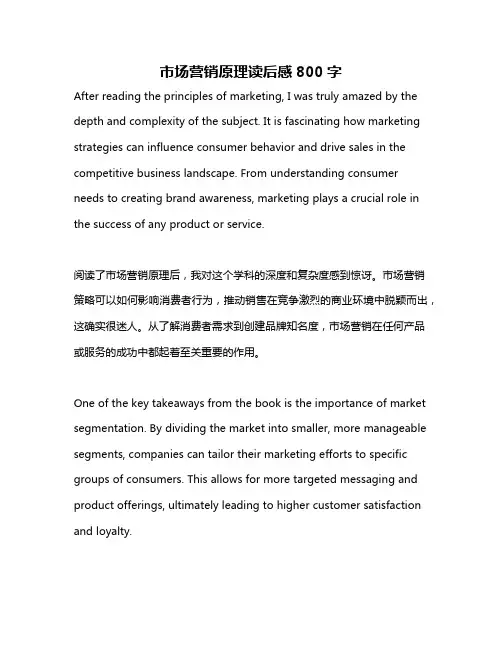
市场营销原理读后感800字After reading the principles of marketing, I was truly amazed by the depth and complexity of the subject. It is fascinating how marketing strategies can influence consumer behavior and drive sales in the competitive business landscape. From understanding consumer needs to creating brand awareness, marketing plays a crucial role in the success of any product or service.阅读了市场营销原理后,我对这个学科的深度和复杂度感到惊讶。
市场营销策略可以如何影响消费者行为,推动销售在竞争激烈的商业环境中脱颖而出,这确实很迷人。
从了解消费者需求到创建品牌知名度,市场营销在任何产品或服务的成功中都起着至关重要的作用。
One of the key takeaways from the book is the importance of market segmentation. By dividing the market into smaller, more manageable segments, companies can tailor their marketing efforts to specific groups of consumers. This allows for more targeted messaging and product offerings, ultimately leading to higher customer satisfaction and loyalty.书中的一个重要启示是市场细分的重要性。
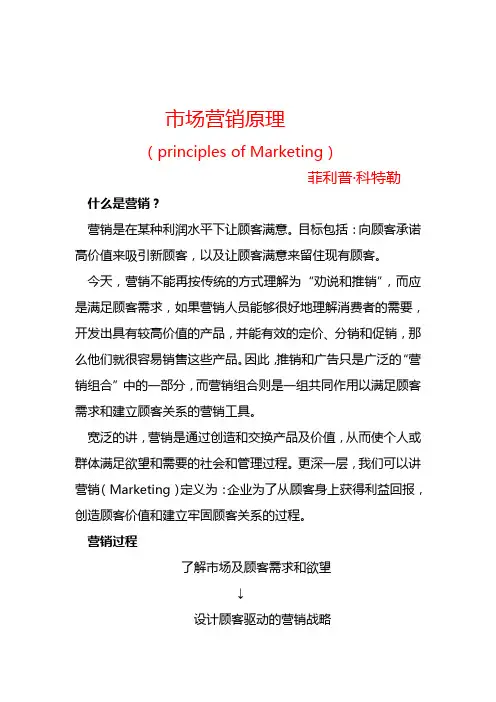
市场营销原理(principles of Marketing)菲利普·科特勒什么是营销?营销是在某种利润水平下让顾客满意。
目标包括:向顾客承诺高价值来吸引新顾客,以及让顾客满意来留住现有顾客。
今天,营销不能再按传统的方式理解为‚劝说和推销‛,而应是满足顾客需求,如果营销人员能够很好地理解消费者的需要,开发出具有较高价值的产品,并能有效的定价、分销和促销,那么他们就很容易销售这些产品。
因此,推销和广告只是广泛的‚营销组合‛中的一部分,而营销组合则是一组共同作用以满足顾客需求和建立顾客关系的营销工具。
宽泛的讲,营销是通过创造和交换产品及价值,从而使个人或群体满足欲望和需要的社会和管理过程。
更深一层,我们可以讲营销(Marketing)定义为:企业为了从顾客身上获得利益回报,创造顾客价值和建立牢固顾客关系的过程。
营销过程了解市场及顾客需求和欲望↓设计顾客驱动的营销战略↓构建传递卓越价值的营销方案↓建立有利可图的关系,并使顾客满意↓从顾客身上收获价值,从而创造利润和顾客资产了解市场和消费者需求营销的基石是人类的需要。
需要(need):指人们感到缺乏的一种状态。
需要不是营销人员创造的,而是人类所固有的。
欲望(want):由人所在的社会决定,由满足需要的东西表现出来。
当考虑到支付能力的时候,欲望就转换为需求(demand)。
营销供给物——产品、服务、体验营销供给物(marketing offer)是提供给某个市场来满足某种需要和欲望的产品、服务、信息和体验的组合。
营销供给物不局限于实体产品,还包括那些用来出售的不可触摸、也不会设计所有权的服务、活动和利益。
许多销售商过多的注重实物产品本身,而忽视了产品所提供的利益,这往往会导致错误。
这些销售商得了‚营销近视症‛。
正是由于这些营销人员被直接欲望所驱动,忽视了对用户需要的仔细分析,他们忘记产品只是消费者用来解决问题的工具。
例子:1、钻头制造商可能认为用户想要的是钻头,但事实上,用户真正想要的是孔。
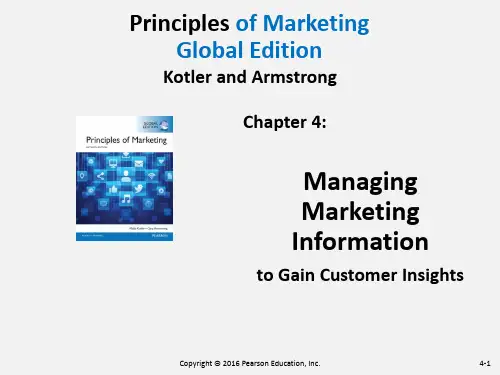
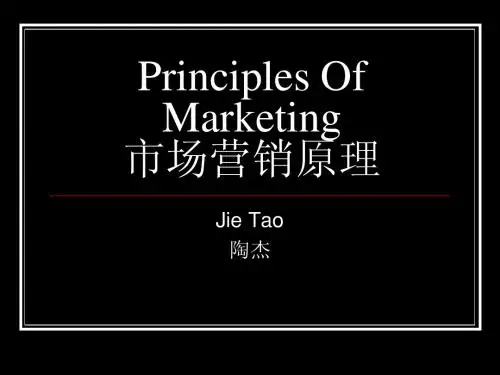

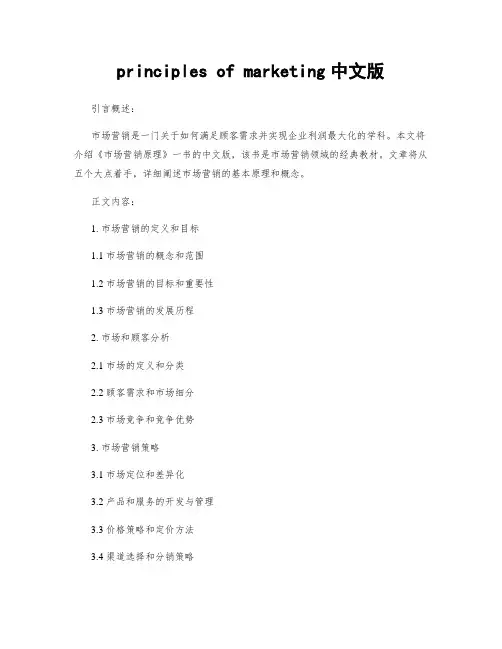
principles of marketing中文版引言概述:市场营销是一门关于如何满足顾客需求并实现企业利润最大化的学科。
本文将介绍《市场营销原理》一书的中文版,该书是市场营销领域的经典教材。
文章将从五个大点着手,详细阐述市场营销的基本原理和概念。
正文内容:1. 市场营销的定义和目标1.1 市场营销的概念和范围1.2 市场营销的目标和重要性1.3 市场营销的发展历程2. 市场和顾客分析2.1 市场的定义和分类2.2 顾客需求和市场细分2.3 市场竞争和竞争优势3. 市场营销策略3.1 市场定位和差异化3.2 产品和服务的开发与管理3.3 价格策略和定价方法3.4 渠道选择和分销策略3.5 促销和营销沟通4. 市场营销的实施和控制4.1 市场营销组织和管理4.2 市场营销计划和预算4.3 市场营销绩效评估和控制5. 市场营销伦理和社会责任5.1 市场伦理和道德问题5.2 市场营销的社会责任5.3 可持续发展和环境保护总结:综上所述,《市场营销原理》一书的中文版详细介绍了市场营销的基本原理和概念。
通过市场和顾客分析,我们可以了解市场的特点和顾客需求,为制定市场营销策略提供依据。
市场营销策略包括市场定位、产品和服务管理、定价、渠道选择和促销等方面。
在市场营销的实施和控制过程中,组织和管理、计划和预算、绩效评估和控制等是关键要素。
最后,市场营销伦理和社会责任的重要性也得到了强调,企业应该秉持道德和社会责任观念,实现可持续发展和环境保护。
总结部分根据文章内容进行了概括,并强调了市场营销伦理和社会责任的重要性,以及企业应该秉持的价值观。
文章结构清晰,内容详尽,符合标题所表达的意思。
stp营销的书-回复
以下是一些关于STP营销的书籍推荐:
1.《市场营销原理》(Principles of Marketing) - 菲利普·科特勒(Philip Kotler)
这本书是市场营销学领域的经典教材之一,涵盖了STP营销的概念和实践。
2.《定位》(Positioning: The Battle for Your Mind) - 阿尔·莱斯,杰克·特劳特(Al Ries, Jack Trout)
这本书通过大量实例和案例来介绍定位战略的重要性,并提供了实用的工具和方法来实施STP策略。
3.《市场定位战略》(Marketing Management: A Strategic Approach) - 李嘉诚(Kevin Lane Keller, Philip Kotler)
该书详细介绍了市场定位战略的核心原则和实践方法,并讨论了如何使用STP策略来建立强大的品牌和提升市场份额。
4.《营销管理:分析、计划和控制》(Marketing Management: Analysis, Planning, and Control) - 帕特里克·弗鲁赖、贝尔和韦克(Philip Kotler, Kevin Lane Keller, Philip T. Kotler)
这本书全面介绍了营销管理的理论和实践,其中包括了STP营销的概念和应用。
无论您是想深入了解STP营销的理论,还是希望获得实际应用的工具和方法,以上书籍都是学习和了解STP营销的不错选择。
principles of marketing中文版《市场营销原理》中文版的学习主要涉及市场营销的基本概念、市场营销组合、消费者行为、市场分析、市场竞争、产品策略、价格策略、促销策略、分销渠道策略以及服务营销等方面。
以下是我为你准备的有关这些主题的详细信息:一、市场营销的基本概念市场营销是关于人类经济活动的一门科学,其目的是通过满足消费者需求来创造价值。
市场营销者通过理解并预测消费者的需求,以及他们自身所能提供的满足方式,来制定和实施营销策略。
二、市场营销组合市场营销组合是影响销售的主要因素,包括产品(Product)、价格(Price)、地点(Place)和促销(Promotion)。
这四个要素的适当组合和协调使用,对于营销成功至关重要。
三、消费者行为消费者行为是研究消费者如何看待、理解和行动产品和服务的学科。
了解消费者的需求、喜好、经济条件和行为习惯,是制定和调整营销策略的关键。
四、市场分析市场分析是对市场状况、趋势和潜在需求进行的研究。
市场营销者通过市场分析,了解市场容量、竞争对手、目标客户以及他们所提供的产品或服务的需求变化。
五、市场竞争市场竞争是指多个公司在同一市场或领域竞争的现象。
为了在竞争中取得优势,公司需要理解并利用竞争环境,创新产品和服务,以及有效地进行市场推广。
六、产品策略产品策略涉及产品的设计、特性、功能以及产品与消费者的关系。
一个成功的产品策略应该考虑到消费者的需求、产品的质量、价格、外观以及生命周期等因素。
七、价格策略价格是市场营销组合中非常重要的一部分。
有效的价格策略应该考虑到产品的成本、消费者的支付意愿以及竞争者的价格。
八、促销策略促销策略涉及如何吸引和保持消费者的注意,激发他们的兴趣和欲望,从而购买产品或服务。
这包括广告、销售推广、公共关系和直接营销等多种手段。
九、分销渠道策略分销渠道是产品从生产者到达消费者所经过的路径,包括直接销售和间接销售两种方式。
有效的分销渠道策略需要考虑产品的特性、消费者的需求以及渠道伙伴的利益。
Chapter 1Marketing:Managing Profitable CustomerRelationships一What Is Marketing?1.Definition2.The Marketing Process3.Wavy’s preferred definition二Understanding the Marketplace and Customer Needs1.Customer Needs, Wants,and Demand2.Market Offerings—Product, Services, and Experiences3.Customer Value and Satisfaction4.Exchanges and Relationships5.Markets are the set of actual and potential buyers of a product6.Marketing systemElements of a Marketing System三Designing a Customer-Driven Marketing Strategy1.Marketing management2.Selecting Customers to Serve3. Market segmentationTarget marketing4.Choosing a Value Proposition5.Marketing Management OrientationsProduction conceptProduct concept&Selling concept&Marketing conceptSocietal concept四Building Customer RelationshipsCustomer Relationship Management (CRM)Chapter 2Company and Marketing Strategy:Partnering to Build Customer Relationships一Companywide Strategic Planning:Defining Marketing’s Role 1.Strategic Planning for a businessStrategic Planning2.Steps in the Strategic Planning Process3.&Defining a Market-Oriented Missiona)The mission statementb)Market-oriented mission statementSetting Company Objectives and Goalsa)Business objectivesb)Marketing objectives&Designing the Business Portfolio1)Definition1)Analyzing the business portfolio1)Strategic business unit (SBU)1)The Boston Group Approacha.Growth share matrixa.SBUs are classified as:Stars; Cash cows;Question marks;Dogs。